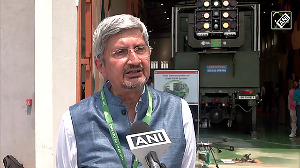There has just been news of a second tsunami in Indonesia; Mumbai is pulling itself together after the bombs; and a recent Reuters survey calls India the sixth most dangerous country in the world for children.
There's certainly no dearth of disasters today. The good news is that there are organisations out there doing their bit to help those in need. Voluntary, non-government organisations try to bridge the yawning gaps in government's aid to the needy and dispossessed.
Sadly, more often than not, these NGOs cannot function as they would like to because they lack funds. Which is where you come in. You have the money and the social conscience, but you don't think you can spend all your time doing good. So, you write out regular cheques to the charity you like the most.
Which is all very well, but what if the organisation you choose spends more on itself than on the needy. Remember the scandal a couple of years back, when an upright senior official quit his chair in a big-ticket NGO? He had hardly walked out of the door that the organisation went on a spending spree - the latest gizmos for members, fancy office gadgets, tablet PCs and the like.
Then there are innumerable cases where NGOs have not filed FCRA (Foreign Contribution Regulation Act) returns and have been put on the prior permission list by the Ministry of Home Affairs. Filing FCRA returns is a must, even if the NGO receives no funds from abroad. The ministry can strip erring NGOs of registration, and the organisation has to apply again to re-register. This can take up to six months, during which time the organisation's reputation is marred.
Know the shocking story of a Haryana-based NGO activist who ran 20 NGOs? In 2002, Capart (Council for Advancement of People's Action and Rural Technology) discovered that he had siphoned off over Rs 1 crore (Rs 10 million) by seeking grants for similar projects from several funding agencies simultaneously. Vigilance officials found that not even 50 per cent of the grant given had been spent on welfare.
Enter CA. The truly unfortunate part of all these scams is that they make it difficult for genuine do-gooders to get money from the public. Which is why an organisation like Credibility Alliance is so welcome. An independent, not-for-profit body, CA was set up after two years of extensive consultations with NGOs, and brings together voluntary organisations to enhance accountability and transparency in the voluntary sector through good governance.
Essentially, CA is a professional body that sets norms or standards of governance. "These norms operate on the principle of self-regulation that respects the autonomy and seeks to preserve the spirit of innovation in the voluntary sector," says CA chairperson B N Makhija. It plans to achieve this by developing a large membership base. Today, its 360-odd members participate in the process of evolving suitable guidelines based on voluntary disclosure of information and adhering to them.
Venkat Krishnan N, director of online charity GiveIndia, also a CA member, draws a parallel with the financial markets. "It is trying to do an equivalent of what Sebi does to listed companies, in the not-for-profit sector," he says. And if the organisation adheres to the norms laid down by the alliance, it is worthy of public support, he adds.
For CA treasurer Mathew Cherian, regulation can help only when the NGOs start becoming more transparent about their overheads. "An NGO can, at most, spend 30 per cent of its expenditure kitty on overheads, and it is extremely difficult to control these overheads because of the service-driven nature of the job," he says. Apart from monitoring the spending of its members, CA also looks into procedural matters to ensure fair play within the sector.
As the organisation evolves accreditation norms to strengthen the credibility of member organisations, it is also eyeing capacity building initiatives that would equip NGOs to meet such norms.
The alliance derives its blueprint from existing social welfare regulation frameworks in the Philippines, Canada and Pakistan. The Philippine Council for NGO Certification, or PCNC, is a private, non-profit organisation that certifies other non-profit organisations which must meet established minimum criteria for financial management and accountability. The certification from PCNC would then serve as the basis for the Bureau of Internal Revenues to grant donee institution status to NGOs.
CA's Panchsheel. While the alliance has ambitious plans regarding a triangular partnership among donors, voluntary organisations and the government, it has a long way to go. With only 360 members on its rolls, and an estimated 4 million plus charities countrywide, the potential is huge. "So far, we were in the process of formulation of norms and now we have just started rolling," says Makhija.
But what does it take for an NGO to qualify for CA certification? Makhija says they have to meet five specific norms, which he calls 'Panchsheel'.
- ldentity. The identity of the organisation should be clear. That is, it should exist and be registered for at least a year. The NGOs' registration documents must be made available on request. A letterhead alone will not suffice.
- Objective. The organisation must state what it aims to achieve, as well as its achievements thus far. It should have defined indicators, which will measure its performance against its stated aims.
- Governance. The composition of the governing board, as well as the name, age, sex, work experience and position of board members will be scrutinised. Makhija elaborates that not more than half of the board members should have remunerative roles, and all remunerations to board members need disclosure. The board should meet twice a year with quorum and have documented minutes of board meetings. Also, the board must approve programmes, budgets, annual reports and audited financial statements.
- Operations. The organisation must conduct its programmes and operations efficiently. For this, the programme activities must be in line with the objective of the organisation. Systems should be in place for proper accounts, personnel, planning and review of operations.
- Transparency and accountability. Simply put, organisations must be made accountable and transparent to internal and external stakeholders. In terms of accountability, signed audited statements must be circulated to stakeholders within eight months of the close of the financial year. Makhija adds that the statements must be made available either on demand or on payment, if necessary.
Accreditation. With these guidelines in place, CA is now looking at setting up an accreditation system to strengthen and enhance the legitimacy and the credibility of individual organisations. It is also promoting capacity building initiatives required to equip voluntary organisations to meet the norms.
"Certified assessors empanelled by CA will go out to voluntary organisations and assess their work," says Makhija. He adds that in case these organisations are found wanting in terms of compliance issues, they would be advised to go to capacity builders, again empanelled by CA.
So, is rating of NGOs the next big thing? Well, it is happening in other parts of the world, so it may not be a far-fetched idea for Indian NGOs. The UK-based Philanthropy Capital brings out analysts' reports of non-profit organisations, quite like what investment bankers churn out stock reports with a buy, sell or hold rating.
Krishnan says, "This is the most likely step in 2-3 years' time, since money has to be made available for research to come up with ratings." Currently, companies and individuals donate Rs 3,000-4,000 crore (Rs 30-40 billion). Krishnan feels that ratings can become feasible only after donations touch Rs 10,000-crore (Rs 100 billion) mark.
The dissenters. Rating and accreditation will definitely add to an NGO's credibility. However, some organisations are wary about the alliance. For instance, CRY (Child Relief and You) has been involved with CA right from its inception, but is still not a member.
Ingrid Sreenath, CEO, CRY, says, "While the CA guidelines ensure transparency, they do not measure effectiveness and the current set of indicators are not satisfactory." Today, CRY is an aggregator, which funds 185 NGOs at the grassroot level.
"Over the years, we have developed a stringent set of norms which measure impact much more than what CA's norms deliver," says Sreenath. Priya Vishwanath, CEO, Charities Aid Foundation, India, says, "We are going through a lot of restructuring, and so have not been able to give CA that much of a thought."
Some of the scepticism seems justified, given that there have been moves since the late 1980s to bring regulation to the social sector. At that point, though, the NGOs fought shy and refused to be party to any government control. But now that CA has been set up as a movement for and by the NGOs, the response should be better.
It is clear that the sector knows that it needs some transparency and accountability. Already, Indianngos.com has a ratings system in place based on the level of compliance of the NGOs to certain indicators developed in association with the help of experts in the social sector.
But while the ambitions may be lofty, there's the very real fear that biases might creep in. The alliance runs the risk of being short-sighted and neglecting the donor. But for now, however, the CA team seems determined to cater to the interests of the donor as well as the recipient. Only time will tell if it succeeds. But for now, it's enough to know that there is some good being done unto those that seek to do good.
Where does India stand?
The Society for Participatory Research in India conducted a one-time study in 2002-03 in association with Johns Hopkins University on India's non-profit sector. The findings:
- Number of charities in India:1.2 million (some estimates put it as high as 4 million). About 20,000 of them are fairly active in developmental work.
- No definitive measure of the size of the charity sector in India. The PRIA study, however, had estimated the size at Rs 17,900 crore ($4 billion) in 1999-2000. Currently, it is estimated to be above Rs 20,000 crore ($4.7 billion).
- Foreign contribution in 2002-03: Rs 5,050 crore ($1.15 billion).
- US contributions come to about Rs 1,490 crore ($339 million) while donations from the UK and Germany are around Rs 670 crore each ($ 153 million).
- About 53 per cent of the charities operate in rural areas.
- Nearly half of these organisations do not have registration.
- About 500 organisations have annual income above Rs 45 lakh ($100,000); most others have annual income of less than Rs 4.5 lakh ($10,000).
- Nearly 20 million people work on a paid or on voluntary basis in India's non-profit sector.







 © 2025
© 2025